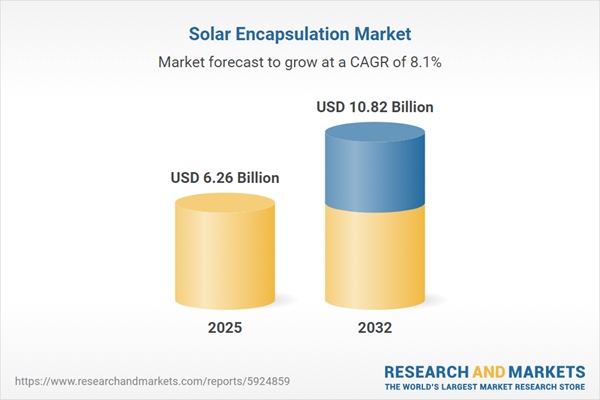Speak directly to the analyst to clarify any post sales queries you may have.
The solar encapsulation market is evolving rapidly, shaped by advancements in material science, regulatory changes, and a growing global commitment to renewable energy. Senior decision-makers seeking sustained photovoltaic performance and reliable operational lifecycles will find this sector’s latest trends, strategic challenges, and actionable opportunities analyzed in depth here.
Market Snapshot: Current Landscape of the Solar Encapsulation Market
The solar encapsulation market grew from USD 5.82 billion in 2024 to USD 6.26 billion in 2025. It is expected to continue growing at a CAGR of 8.05%, reaching USD 10.82 billion by 2032. This trajectory reflects sustained investment in photovoltaic technologies, as companies across the value chain push for improved durability, efficiency, and system reliability. Solar encapsulation is increasingly recognized as a critical component for protecting photovoltaic modules from environmental exposures while supporting enhanced energy conversion standards.
Scope & Segmentation: Defining the Solar Encapsulation Value Chain
This report provides a comprehensive analysis of the solar encapsulation market, detailing key dimensions that impact strategic decision-making and supply chain resilience:
- Material Types: Ethylene Vinyl Acetate, Ionomer, Poly Vinyl Butyral, Polyolefin (PO), Thermoplastic Polyurethane.
- Technologies: Crystalline Silicon Solar, Thin-Film Solar.
- Installation Types: Building-Integrated Photovoltaic, Floating Photovoltaic, Ground-Mounted.
- End-Use Sectors: Agricultural, Commercial, Industrial, Residential, Utilities.
- Regional Coverage: Americas (including United States, Canada, Mexico, Brazil, Argentina, Chile, Colombia, Peru), Europe, Middle East & Africa (encompassing United Kingdom, Germany, France, Russia, Italy, Spain, Netherlands, Sweden, Poland, Switzerland, United Arab Emirates, Saudi Arabia, Qatar, Turkey, Israel, South Africa, Nigeria, Egypt, Kenya), Asia-Pacific (China, India, Japan, Australia, South Korea, Indonesia, Thailand, Malaysia, Singapore, Taiwan).
- Leading Companies: 3M Company, Alishan Green Energy Pvt. Ltd., Astenik Solar Inc., Borealis AG, BREYER Maschinenfabrik GmbH, China JWELL Intelligent Machinery Co.,Ltd., Cybrid Technologies Inc., Dai Nippon Printing Co., Ltd., Dunmore Corporation, ENERLITE SOLAR FILMS INDIA PVT LTD, Enrich Encap Pvt Ltd., Hangzhou First Applied Materials Co., Ltd., Heliatek GmbH, JA Solar Technology Co., Ltd., Lucent CleanEnergy, Mitsubishi Chemical Corporation, Mitsui Chemicals Group, Navitas Alpha Renewables Private Limited, RenewSys India Pvt. Ltd., Saint-Gobain S.A., Shenzhen Gaoren Electronic New Material Co. Ltd., Targray Technology International Inc., The Dow Chemical Company, USEON Technology Limited, Vishakha Renewables Pvt. Ltd.
Key Takeaways: Strategic Insights for Decision-Makers
- Material innovation is driving solar encapsulation performance, with newer chemistries delivering improved resistance to UV degradation, yellowing, and extreme climates.
- Regulatory frameworks are influencing encapsulant formulations, requiring compliance with stricter environmental standards and recyclability mandates across multiple regions.
- Tightening trade policies, particularly United States tariffs, are reshaping sourcing strategies and prompting increased investments in domestic manufacturing capability.
- Collaborative research and co-development between module manufacturers and material suppliers are accelerating new encapsulant solutions aligned with certification protocols.
- Technology advancements, such as real-time quality monitoring and process automation, are supporting higher yield and reduced warranty risk for solar projects.
- Regional market dynamics—including climate diversity, procurement preferences, and incentive programs—are dictating distinct encapsulant design and deployment priorities.
Tariff Impact: Navigating Policy and Supply Chain Complexity
Recent tariff adjustments in the United States have introduced additional volatility and complexity into polymer sourcing and encapsulant supply chains. Organizations are reassessing procurement strategies, seeking more localized production options, and diversifying supplier relationships to maintain continuity and mitigate risks associated with geopolitical developments and increased logistics costs.
Methodology & Data Sources
This market intelligence synthesizes primary interviews with industry experts, manufacturing specialists, and material scientists, combined with secondary reviews of technical publications, regulatory dossiers, and financial disclosures. Analytical methods such as SWOT, value chain mapping, and iterative expert validation ensure reliable, pragmatic conclusions for leadership teams.
Why This Report Matters
- Equips executive teams with clear insights on solar encapsulation market structures, technology advancements, and policy influences to support high-impact investment decisions.
- Highlights actionable market trends and segment opportunities for optimizing product portfolios and accelerating innovation partnerships.
- Delivers data-driven benchmarks and best practices that sharpen competitive positioning, supply chain agility, and operational resilience within the renewable energy sector.
Conclusion
The solar encapsulation market is positioned for ongoing transformation as technology advancements, regulatory changes, and regional drivers intersect. Organizations that leverage forward-looking strategies and collaborative innovation will capture enduring value as global photovoltaic deployment expands.
Additional Product Information:
- Purchase of this report includes 1 year online access with quarterly updates.
- This report can be updated on request. Please contact our Customer Experience team using the Ask a Question widget on our website.
Table of Contents
3. Executive Summary
4. Market Overview
7. Cumulative Impact of Artificial Intelligence 2025
Companies Mentioned
The companies profiled in this Solar Encapsulation market report include:- 3M Company
- Alishan Green Energy Pvt. Ltd.
- Astenik Solar Inc.
- Borealis AG
- BREYER Maschinenfabrik GmbH
- China JWELL Intelligent Machinery Co.,Ltd.
- Cybrid Technologies Inc.
- Dai Nippon Printing Co., Ltd.
- Dunmore Corporation
- ENERLITE SOLAR FILMS INDIA PVT LTD
- Enrich Encap Pvt Ltd.
- Hangzhou First Applied Materials Co., Ltd.
- Heliatek GmbH
- JA Solar Technology Co., Ltd.
- Lucent CleanEnergy
- Mitsubishi Chemical Corporation
- Mitsui Chemicals Group
- Navitas Alpha Renewables Private Limited
- RenewSys India Pvt. Ltd.
- Saint-Gobain S.A.
- Shenzhen Gaoren Electronic New Material Co. Ltd.
- Targray Technology International Inc.
- The Dow Chemical Company
- USEON Technology Limited
- Vishakha Renewables Pvt. Ltd.
Table Information
| Report Attribute | Details |
|---|---|
| No. of Pages | 196 |
| Published | November 2025 |
| Forecast Period | 2025 - 2032 |
| Estimated Market Value ( USD | $ 6.26 Billion |
| Forecasted Market Value ( USD | $ 10.82 Billion |
| Compound Annual Growth Rate | 8.0% |
| Regions Covered | Global |
| No. of Companies Mentioned | 26 |









